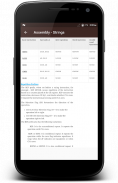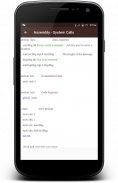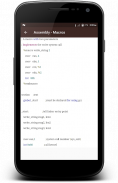








Assembly Language

Assembly Language ਦਾ ਵੇਰਵਾ
✴ An assembly language is a low-level programming language designed for a specific type of processor. It may be produced by compiling source code from a high-level programming language (such as C/C++) but can also be written from scratch. Assembly code can be converted to machine code using an assembler.✴
► This App has been designed for those who want to learn the basics of assembly programming from scratch. This App will give you enough understanding on assembly programming from where you can take yourself to higher levels of expertise.✦
【Topics Covered in this App are Listed Below】
⇢ Introduction
⇢ Environment Setup
⇢ Basic Syntax
⇢ Memory Segments
⇢ Registers
⇢ System Calls
⇢ Addressing Modes
⇢ Variables
⇢ Constants
⇢ Arithmetic Instructions
⇢ Logical Instructions
⇢ Conditions
⇢ Loops
⇢ Numbers
⇢ Strings
⇢ Arrays
⇢ Procedures
⇢ Recursion
⇢ Macros
⇢ File Management
⇢ Memory Management
⇢ What’s Right With Assembly Language?
⇢ Data Organization
⇢ Nibbles
⇢ Bytes
⇢ Words
⇢ Double Words
⇢ The Hexadecimal Numbering System
⇢ Logical Operations on Binary Numbers and Bit Strings
⇢ Sign and Zero Extension
⇢ Shifts and Rotates
⇢ Boolean Algebra
⇢ Correspondence Between Electronic Circuits and Boolean Functions
⇢ The Basic System Components
⇢ The Data Bus
⇢ The Address Bus
⇢ The Memory Subsystem
⇢ System Timing
⇢ The System Clock
⇢ Memory Access and the System Clock
⇢ Wait States
⇢ CPU Registers
⇢ The Bus Interface Unit
⇢ I/O (Input/Output)
⇢ Assembling Your Code with MASM
⇢ Declaring Variables in an Assembly Language Program
⇢ Declaring and using WORD Variables
⇢ Declaring and using DWORD Variables
⇢ The Processor Status Register (Flags)
⇢ Hyperthreading
⇢ AMD processors
⇢ Multiprecision Operations
⇢ Flags
⇢ Control & System flags
⇢ Preventing LOOP catastrophes
⇢ Integers
⇢ Binary Coded Decimal
⇢ Floating-Point Numbers
⇢ Memory Management Routines: MEMINIT, MALLOC, and FREE
⇢ Integer Constants
⇢ Segment Prefixes
⇢ The END Directive
⇢ Macros


























